Think that you may own a portrait of Thomas Jefferson? We authenticate, appraise and issue Certificates of Authenticity (COA) for all portraits of Thomas Jefferson.
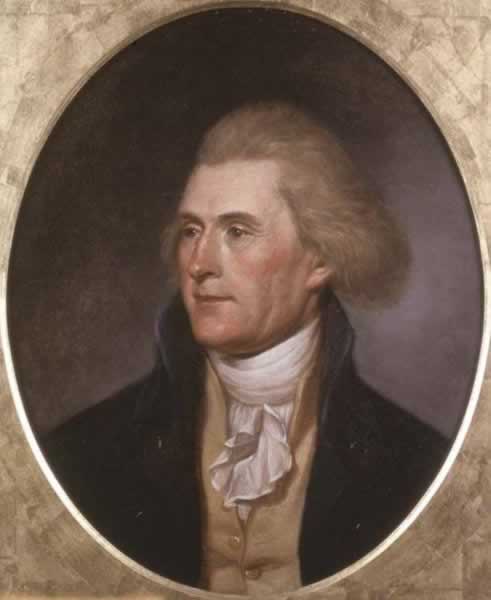
Thomas Jefferson was the third President of the United States (1801-1809), the principal author of the Declaration of Independence (1776), and one of the most influential Founding Fathers for his promotion of the ideals of Republicanism in the United States. Major events during his presidency include the Louisiana Purchase (1803) and the Lewis and Clark Expedition (1804-1806).
There are many portraits of Thomas Jefferson in existence, particularly from the 1790's until his death in 1826. However, there are few, if any, paintings of Jefferson as a child or a young man in existence.
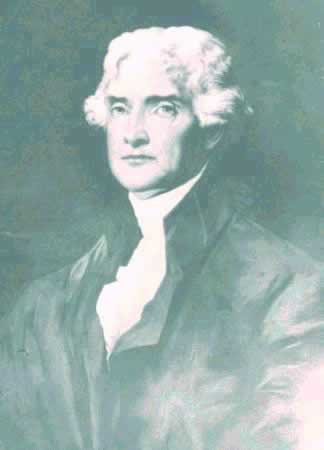
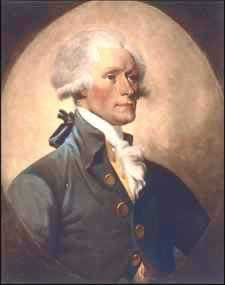
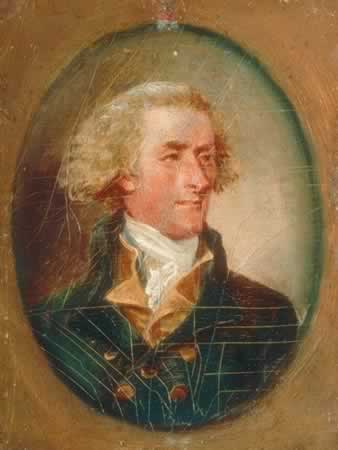
As a political philosopher, Jefferson was a man of the Enlightenment and knew many intellectual leaders in Britain and France. He idealized the independent yeoman farmer as exemplar of republican virtues, distrusted cities and financiers, and favored states' rights and a strictly limited federal government. Jefferson supported the separation of church and state and was the author of the Virginia Statute for Religious Freedom (1779, 1786). He was the eponym of Jeffersonian democracy and the co-founder and leader of the Democratic-Republican Party, which dominated American politics for a quarter-century and was the precursor of the modern-day Democratic Party. Jefferson served as the wartime Governor of Virginia (1779-1781), first United States Secretary of State (1789-1793) and second Vice President (1797-1801).
A polymath, Jefferson achieved distinction as, among other things, a horticulturist, statesman, architect, archaeologist, paleontologist, author, inventor and founder of the University of Virginia. When President John F. Kennedy welcomed forty-nine Nobel Prize winners to the White House in 1962 he said, "I think this is the most extraordinary collection of talent and of human knowledge that has ever been gathered together at the White House - with the possible exception of when Thomas Jefferson dined alone."
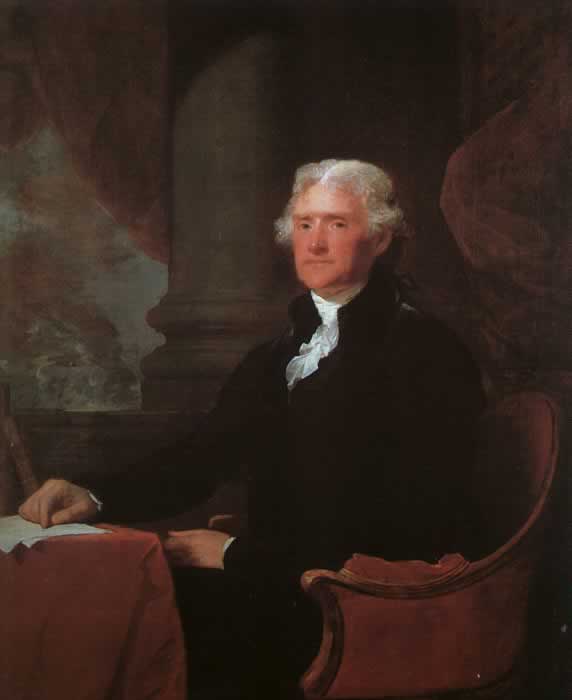
Thomas Jefferson was born on April 13, 1743 into a family closely related to some of the most prominent individuals in Virginia, the third of eight children. His mother was Jane Randolph, daughter of Isham Randolph, a ship's captain and sometime planter, and first cousin to Peyton Randolph. Jefferson's father was Peter Jefferson, a planter and surveyor who owned plantations in Albemarle County (Shadwell, then Edge Hill, Virginia.) He was of English descent and belonged to the Haplogroup K2.
In 1752, Jefferson began attending a local school run by William Douglas, a Scottish minister. At the age of nine, Jefferson began studying Latin, Greek, and French. In 1757, when he was 14 years old, his father died. Jefferson inherited about 5,000 acres of land and dozens of slaves. He built his home there, which eventually became known as Monticello.
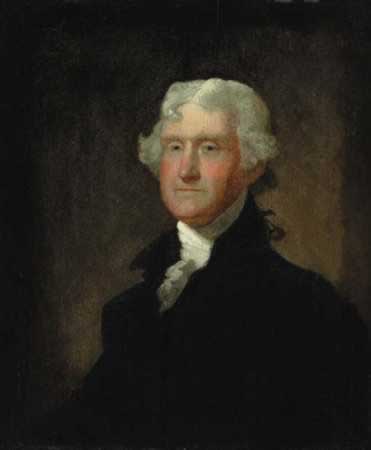
After his father's death, he was taught at the school of the learned minister James Maury from 1758 to 1760. The school was in Fredericksville Parish near Gordonsville, Virginia, twelve miles from Shadwell, and Jefferson boarded with Maury's family. There he received a classical education and studied history and science.
In 1760 Jefferson entered The College of William & Mary in Williamsburg at the age of 16; he studied there for two years, graduating with highest honors in 1762. At William & Mary, he enrolled in the philosophy school and studied mathematics, metaphysics, and philosophy under Professor William Small, who introduced the enthusiastic Jefferson to the writings of the British Empiricists, including John Locke, Francis Bacon, and Isaac Newton (Jefferson called them the "three greatest men the world had ever produced"). He also perfected his French, carried his Greek grammar book wherever he went, practiced the violin, and read Tacitus and Homer. A keen and diligent student, Jefferson displayed an avid curiosity in all fields and, according to the family tradition, frequently studied fifteen hours a day. His closest college friend, John Page of Rosewell, reported that Jefferson "could tear himself away from his dearest friends to fly to his studies."
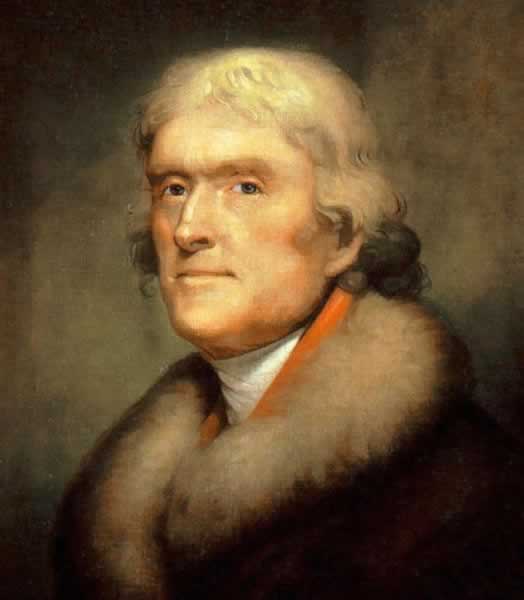
While in college, Jefferson was a member of a secret organization called the Flat Hat Club, now the namesake of the William & Mary student newspaper. He lodged and boarded at the College in the building known today as the Sir Christopher Wren Building, attending communal meals in the Great Hall, and morning and evening prayers in the Wren Chapel. Jefferson often attended the lavish parties of royal governor Francis Fauquier, where he played his violin and developed an early love for wines. After graduating in 1762 with highest honors, he studied law with his friend and mentor, George Wythe, and was admitted to the Virginia bar in 1767.
In 1772, Jefferson married a 23-year-old widow, Martha Wayles Skelton Jefferson. They had six children: Martha Jefferson Randolph (1772-1836), Jane Randolph (1774-1775), a stillborn or unnamed son (1777), Mary Wayles (1778-1804), Lucy Elizabeth (1780-1781), and Lucy Elizabeth (1782-1785). Martha died on September 6, 1782 and Jefferson never remarried. Jefferson may also have been the father of several children with his slave Sally Hemings.
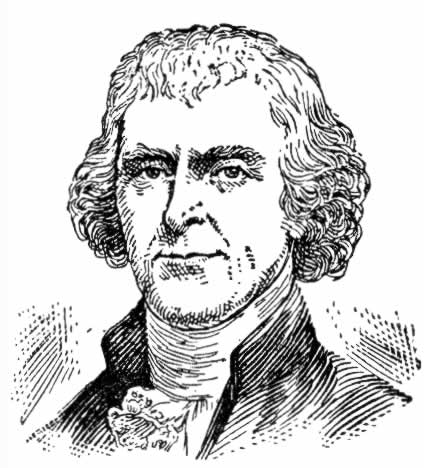
Jefferson practiced law and served in the Virginia House of Burgesses. In 1774, he wrote, A Summary View of the Rights of British America which was intended as instructions for the Virginia delegates to a national congress. The pamphlet was a powerful argument of American terms for a settlement with Britain. It helped speed the way to independence, and marked Jefferson as one of the most thoughtful patriot spokesmen.
In an uncanny twist of fate Richard Henry Lee, who authored the July 2, 1776 resolution declaring independence from Great Britain, was called home to Virginia due to the illness of his wife. Thomas Jefferson was appointed by the Continental Congress of the United Colonies in his place as the Committee of Five's Chairman to prepare a draft of the proposed Declaration of Independence. Congress also chose John Adams, Benjamin Franklin, Robert Livingston, and Roger Sherman. The committee assigned Thomas Jefferson the task of producing a draft Declaration for its consideration. Jefferson's creation of the original draft took place in seventeen days between his appointment on the committee until the report of draft to Congress on June 28, 1776. Jefferson drew heavily on George Mason's Virginia Declaration of Rights (passed on June 12, 1776), state and local calls for independence, and his own work on the Virginia Constitution. 26 changes were made from Jefferson's original draft by the Committee of Five. On July 4, 1776, the resolution was passed two days after Independence was declared. Jefferson is considered to be the primary author.
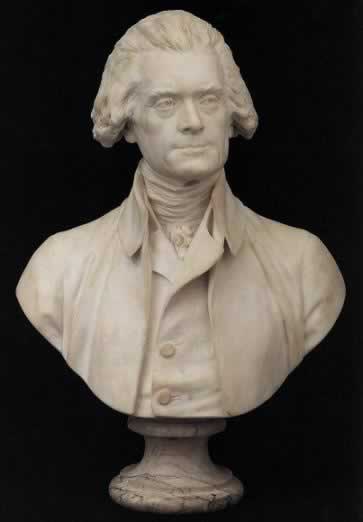
In September 1776, Jefferson returned to Virginia and was elected to the new Virginia House of Delegates. During his term in the House, Jefferson set out to reform and update Virginia's system of laws to reflect its new status as a democratic state. He drafted 126 bills in three years, including laws to abolish primogeniture, establish freedom of religion, and streamline the judicial system. In 1778, Jefferson's "Bill for the More General Diffusion of Knowledge" led to several academic reforms at his alma mater, including an elective system of study - the first in an American university.
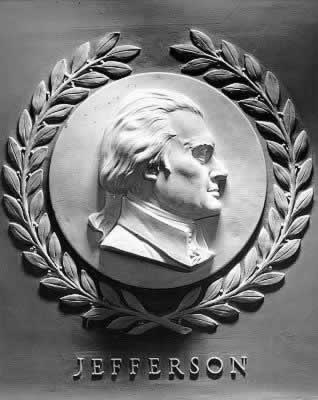
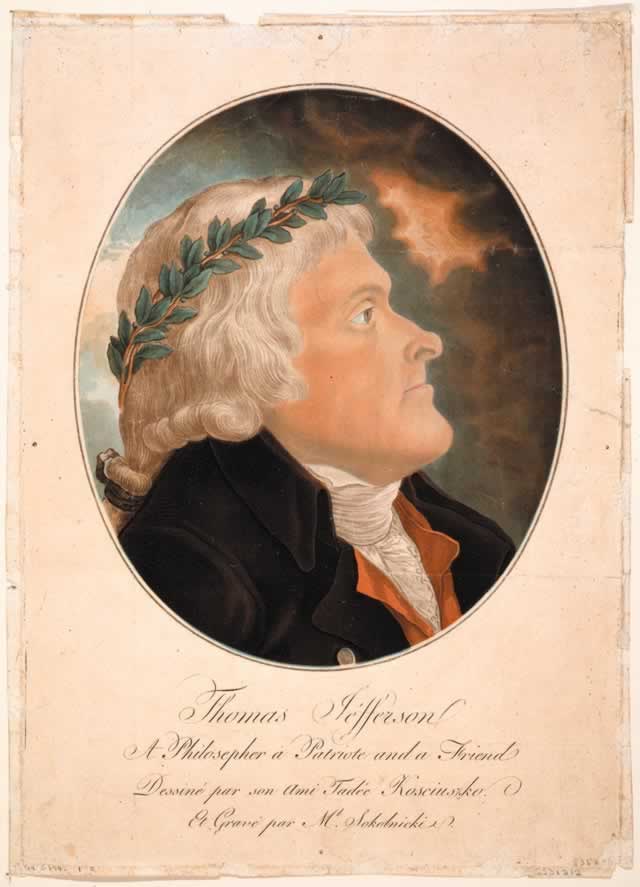
Jefferson served as governor of Virginia from 1779-1781. As governor, he oversaw the transfer of the state capitol from Williamsburg to the more central location of Richmond in 1780. He continued to advocate educational reforms at the College of William and Mary, including the nation's first student-policed honor code. In 1779, at Jefferson's behest, William and Mary appointed George Wythe to be the first professor of law in an American university. Dissatisfied with the rate of changes he wanted to push through, he later became the founder of the University of Virginia, which was the first university in the United States at which higher education was completely separate from religious doctrine.
Virginia was invaded twice by the British during Jefferson's term as governor. He, along with Patrick Henry and other leaders of Virginia, were but ten minutes away from being captured by Banastre Tarleton, a British colonel leading a cavalry column that was raiding the area in June 1781. Public disapproval of his performance delayed his future political prospects, and he was never again elected to office in Virginia.
Because Jefferson served as minister to France from 1785 to 1789, he was not able to attend the Philadelphia Convention. He generally supported the new constitution despite the lack of a bill of rights and was kept informed by his correspondence with James Madison. While in Paris, he lived in a residence on the Champs-Élysées.
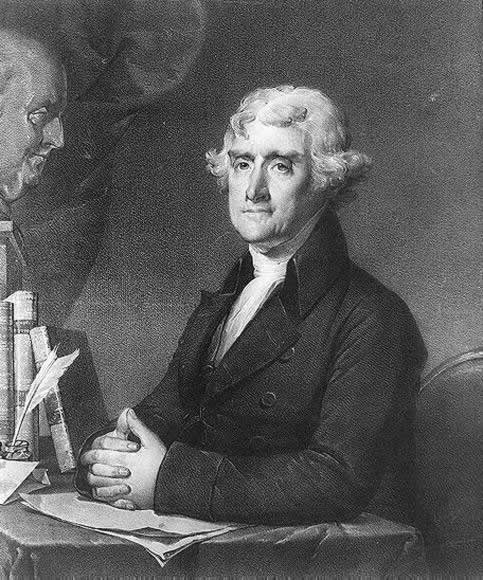
After returning from France, Jefferson served as the first Secretary of State under Thomas Jefferson (1789-1793). Jefferson and Alexander Hamilton began sparring over national fiscal policy, especially the funding of the debts of the war, with Hamilton believing that the debts should be equally shared, and Jefferson believing that each state should be responsible for its own debt (Virginia had not accumulated much debt during the Revolution). In further sparring with the Federalists, Jefferson came to equate Hamilton and the rest of the Federalists with Tories and monarchists who threatened to undermine republicanism. He equated Federalism with "Royalism," and made a point to state that "Hamiltonians were panting after...and itching for crowns, coronets and mitres." Jefferson and James Madison founded and led the Democratic-Republican Party. He worked with Madison and his campaign manager John J. Beckley to build a nationwide network of Republican allies to combat Federalists across the country.
Jefferson strongly supported France against Britain when war broke out between those nations in 1793. Historian Lawrence S. Kaplan notes Jefferson's "visceral support for the French cause," while agreeing with Washington that the nation should not get involved in the fighting. The arrival in 1793 of an aggressive new French minister, Edmond-Charles Genêt, caused a crisis for the Secretary of State, as he watched Genêt try to violate American neutrality, manipulate public opinion, and even go over Washington's head in appealing to the people; projects that Jefferson helped to thwart. According to Schachner, Jefferson believed that political success at home depended on the success of the French army in Europe.
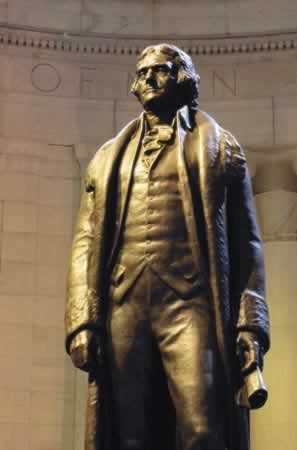
Jefferson at the end of 1793 retired to Monticello where he continued to orchestrate opposition to Hamilton and Washington. However, the Jay Treaty of 1794, orchestrated by Hamilton, brought peace and trade with Britain - while Madison, with strong support from Jefferson, wanted, Miller says, "to strangle the former mother country" without actually going to war. "It became an article of faith among Republicans that 'commercial weapons' would suffice to bring Great Britain to any terms the United States chose to dictate." Jefferson, in retirement, strongly encouraged Madison.
As the Republican candidate in 1796 he lost to John Adams, but had enough electoral votes to become Vice President (1797-1801). He wrote a manual of parliamentary procedure, but otherwise avoided the Senate.
With the Quasi-War, an undeclared naval war with France, underway, the Federalists under John Adams started a navy, built up the army, levied new taxes, readied for war, and enacted the Alien and Sedition Acts in 1798. Jefferson interpreted the Alien and Sedition Acts as an attack on his party more than on dangerous enemy aliens; they were used to attack his party, with the most notable attacks coming from Matthew Lyon, congressman of Vermont. He and Madison rallied support by anonymously writing the Kentucky and Virginia Resolutions, which declared that the federal government had no right to exercise powers not specifically delegated to it by the states. The Resolutions meant that, should the federal government assume such powers, its acts under them could be voided by a state. The Resolutions presented the first statements of the states' rights theory, that later led to the concepts of nullification and interposition.
Working closely with Aaron Burr of New York, Jefferson rallied his party, attacking the new taxes especially, and stood for the Presidency in 1800. Consistent with the traditions of the times, he did not formally campaign for the position. Prior to the passage of the 12th Amendment, a problem with the new union's electoral system arose. He tied with Burr for first place in the Electoral College, leaving the House of Representatives (where the Federalists still had some power) to decide the election.
After lengthy debate within the Federalist-controlled House, Hamilton convinced his party that Jefferson would be a lesser political evil than Burr and that such scandal within the electoral process would undermine the still-young regime. The issue was resolved by the House, on 17 February 1801 after thirty-six ballots, when Jefferson was elected President and Burr Vice President. Burr's refusal to remove himself from consideration created ill will with Jefferson, who dropped Burr from the ticket in 1804 after Burr killed Hamilton in a duel.
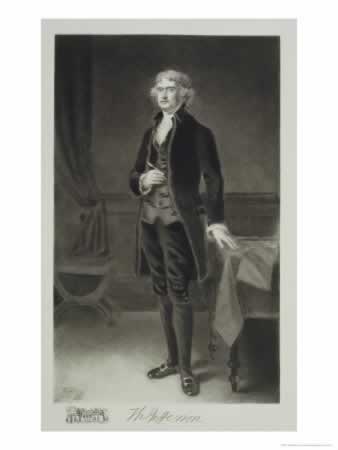
After leaving the Presidency, Jefferson continued to be active in public affairs. He also became increasingly concerned with founding a new institution of higher learning, specifically one free of church influences where students could specialize in many new areas not offered at other universities. Jefferson believed educating people was a good way to establish an organized society, and also felt schools should be paid for by the general public, so less wealthy people could obtain student membership as well. A letter to Joseph Priestley, in January, 1800, indicated that he had been planning the University for decades before its establishment.
His dream was realized in 1819 with the founding of the University of Virginia. Upon its opening in 1825, it was then the first university to offer a full slate of elective courses to its students. One of the largest construction projects to that time in North America, it was notable for being centered about a library rather than a church. In fact, no campus chapel was included in his original plans. Until his death, Jefferson invited students and faculty of the school to his home; Edgar Allan Poe was among those students.
Jefferson is widely recognized for his architectural planning of the UVA campus, an innovative design that is a powerful representation of his aspirations for both state sponsored education and an agrarian democracy in the new Republic. His educational idea of creating specialized units of learning is physically expressed in the configuration of his campus plan, which he called the "Academical Village." Individual academic units are expressed visually as distinct structures, represented by Pavilions, facing a grassy quadrangle, with each Pavilion housing classroom, faculty office, and residences. Though unique, each is visually equal in importance, and they are linked together with a series of open air arcades that are the front facades of student accommodations. Gardens and vegetable plots are placed behind surrounded by serpentine walls, affirming the importance of the agrarian lifestyle.
His highly ordered site plan establishes an ensemble of buildings surrounding a central rectangular quadrangle, named The Lawn, which is lined on either side with the academic teaching units and their linking arcades. The quad is enclosed at one end with the library, the repository of knowledge, at the head of the table. The remaining side opposite the library remained open-ended for future growth. The lawn rises gradually as a series of stepped terraces, each a few feet higher than the last, rising up to the library set in the most prominent position at the top, while also suggesting that the Academical Village facilitates easier movement to the future.
Stylistically, Jefferson was a proponent of the Greek and Roman styles, which he believed to be most representative of American democracy by historical association. Each academic unit is designed with a two story temple front facing the quadrangle, while the library is modeled on the Roman Pantheon. The ensemble of buildings surrounding the quad is an unmistakable architectural statement of the importance of secular public education, while the exclusion of religious structures reinforces the principal of separation of church and state. The campus planning and architectural treatment remains today as a paradigm of the ordering of manmade structures to express intellectual ideas and aspirations. A survey of members of the American Institute of Architects identified Jefferson's campus as the most significant work of architecture in America.
The University was designed as the capstone of the educational system of Virginia. In his vision, any citizen of the commonwealth could attend school with the sole criterion being ability.
Jefferson died on the Fourth of July, 1826, the 50th anniversary of the adoption of the Declaration of Independence. He died a few hours before the death of John Adams, co-signer of the Declaration of Independence, one time political rival and later friend and correspondent.
Although he was born into one of the wealthiest families in the United States, Thomas Jefferson was deeply in debt when he died. His possessions were sold at auction. In 1831, Jefferson's 552 acres (223 hectares) were sold for $7,000 to James T. Barclay. Thomas Jefferson is buried on his Monticello estate, in Charlottesville, Virginia. In his will, he left Monticello to the United States to be used as a school for orphans of navy officers. His epitaph, written by him with an insistence that only his words and "not a word more" be inscribed, reads:
AUTHOR OF THE DECLARATION OF AMERICAN INDEPENDENCE
OF THE STATUTE OF VIRGINIA FOR RELIGIOUS FREEDOM
AND FATHER OF THE UNIVERSITY OF VIRGINIA
Jefferson has been described by many people as a thin, tall man, who stood at approximately six feet and remarkably straight.
"The Sage of Monticello" cultivated an image that earned him the other nickname, "Man of the People." He affected a popular air by greeting White House guests in homespun attire like a robe and slippers. Dolley Madison, wife of James Madison (Jefferson's secretary of state), and Jefferson's daughters relaxed White House protocol and turned formal state dinners into more casual and entertaining social events. Although a foremost defender of a free press, Jefferson at times sparred with partisan newspapers and appealed to the people.
Jefferson's writings were utilitarian and evidenced great intellect, and he had an affinity for languages. He learned Gaelic in order to translate Ossian, and sent to James Macpherson for the originals.
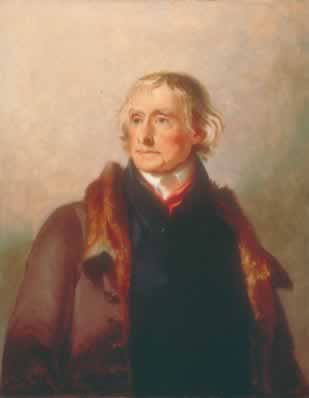
As President, he discontinued the practice of delivering the State of the Union Address in person, instead sending the address to Congress in writing (the practice was eventually revived by Woodrow Wilson); he gave only two public speeches during his Presidency. Jefferson had a lisp and preferred writing to public speaking partly because of this. He burned all of his letters between himself and his wife at her death, creating the portrait of a man who at times could be very private. Indeed, he preferred working in the privacy of his office than the public eye.
Jefferson was an accomplished architect who was extremely influential in bringing the Neo-Palladian style - popular among the Whig aristocracy of Britain - to the United States. The style was associated with Enlightenment ideas of republican civic virtue and political liberty. Jefferson designed his famous home, Monticello, near Charlottesville, Virginia; it included automatic doors, the first swivel chair, and other convenient devices invented by Jefferson. Nearby is the only university ever to have been founded by a U.S. president, the University of Virginia, of which the original curriculum and architecture Jefferson designed. Today, Monticello and the University of Virginia are together one of only four man-made World Heritage Sites in the United States of America. Jefferson also designed Poplar Forest, near Lynchburg, in Bedford County, Virginia, as a private retreat from a very public life. Jefferson is also credited with the architectural design of the Virginia State Capitol building, which was modeled after the Maison Carrée at Nîmes in southern France, an ancient Roman temple. Jefferson's buildings helped initiate the ensuing American fashion for Federal architecture.
Jefferson's interests included archeology, a discipline then in its infancy. He has sometimes been called the "father of archeology" in recognition of his role in developing excavation techniques. When exploring an Indian burial mound on his Virginia estate in 1784, Jefferson avoided the common practice of simply digging downwards until something turned up. Instead, he cut a wedge out of the mound so that he could walk into it, look at the layers of occupation, and draw conclusions from them.
Thomas Jefferson enjoyed his fish pond at Monticello. It was around three feet deep and mortar lined. He used the pond to keep fish that were recently caught as well as to keep eels fresh. This pond has been restored and can be seen from the west side of Monticello.
In 1780, he joined Benjamin Franklin's American Philosophical Society. He served as president of the society from 1797 to 1815.
Jefferson was an avid wine lover and noted gourmet. During his years in France (1784-1789) he took extensive trips through French and other European wine regions and sent the best back home. He is noted for the bold pronouncement: "We could in the United States make as great a variety of wines as are made in Europe, not exactly of the same kinds, but doubtless as good." While there were extensive vineyards planted at Monticello, a significant portion were of the European wine grape Vitis vinifera and did not survive the many vine diseases native to the Americas.
In 1801, he published A Manual of Parliamentary Practice that is still in use. In 1812 Jefferson published a second edition.
After the British burned Washington, D.C. and the Library of Congress in August 1814, Jefferson offered his own collection to the nation. In January 1815, Congress accepted his offer, appropriating $23,950 for his 6,487 books, and the foundation was laid for a great national library. Today, the Library of Congress' website for federal legislative information is named THOMAS, in honor of Jefferson. His two-volume 1764 edition of the Qur'an was used by Rep. Keith Ellison in 2007 for his swearing in to the House of Representatives.
Jefferson was a leader in developing republicanism in the United States. He insisted that the British aristocratic system was inherently corrupt and that Americans' devotion to civic virtue required independence. In the 1790s he repeatedly warned that Hamilton and Adams were trying to impose a British-like monarchical system that threatened republicanism. He supported the War of 1812, hoping it would drive away the British military and ideological threat from Canada. Jefferson's vision for American virtue was that of an agricultural nation of yeoman farmers minding their own affairs. It stood in contrast to the vision of Alexander Hamilton, who envisioned a nation of commerce and manufacturing, which Jefferson said offered too many temptations to corruption. Jefferson's deep belief in the uniqueness and the potential of America made him the father of American exceptionalism. In particular, he was confident that an under-populated America could avoid what he considered the horrors of class-divided, industrialized Europe.
Jefferson's republican political principles were heavily influenced by the Country Party of 18th century British opposition writers. He was influenced by John Locke (particularly relating to the principle of inalienable rights). Historians find few traces of any influence by his French contemporary, Jean-Jacques Rousseau.
His opposition to the Bank of the United States was fierce: "I sincerely believe, with you, that banking establishments are more dangerous than standing armies; and that the principle of spending money to be paid by posterity, under the name of funding, is but swindling futurity on a large scale." Nevertheless Madison and Congress, seeing the financial chaos caused by the lack of a national bank in the War of 1812, disregarded his advice and created the Second Bank of the United States in 1816.
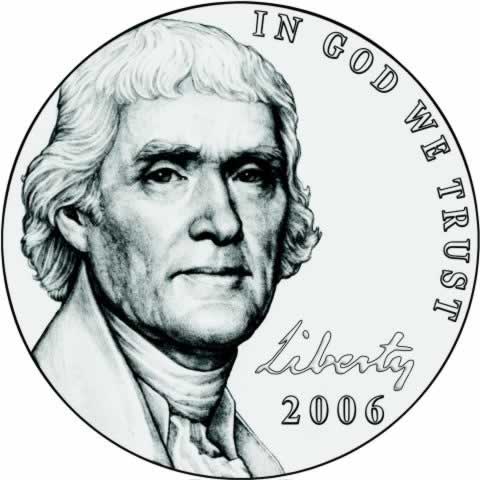
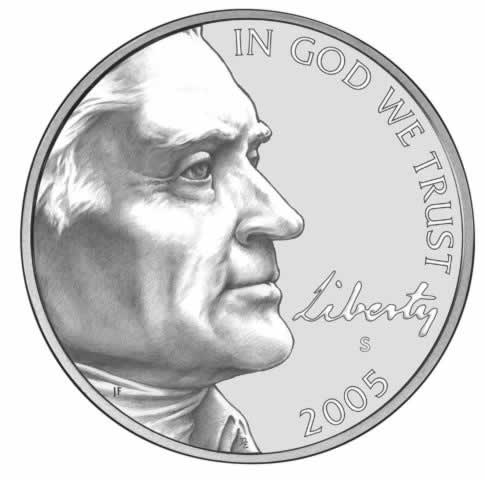
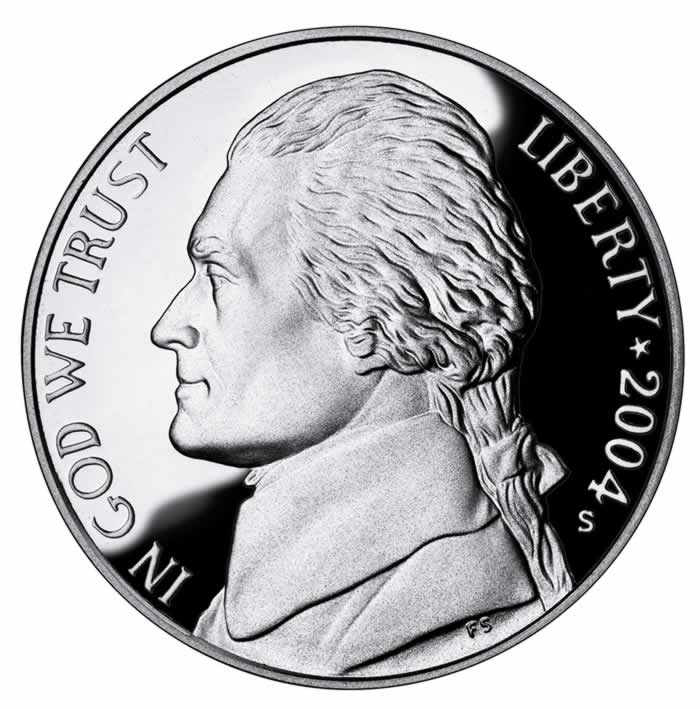
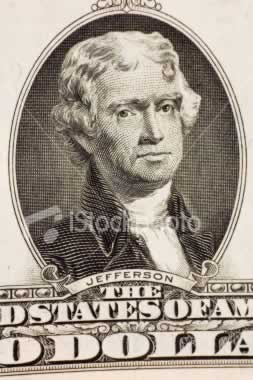
Jefferson believed that each individual has "certain inalienable rights." That is, these rights exist with or without government; man cannot create, take, or give them away. It is the right of "liberty" on which Jefferson is most notable for expounding. He defines it by saying "rightful liberty is unobstructed action according to our will within limits drawn around us by the equal rights of others. I do not add 'within the limits of the law,' because law is often but the tyrant's will, and always so when it violates the rights of the individual." Hence, for Jefferson, though government cannot create a right to liberty, it can indeed violate it. And the limit of an individual's rightful liberty is not what law says it is but is simply a matter of stopping short of prohibiting other individuals from having the same liberty. A proper government, for Jefferson, is one that not only prohibits individuals in society from infringing on the liberty of other individuals, but also restrains itself from diminishing individual liberty.
Jefferson's commitment to equality was expressed in his successful efforts to abolish primogeniture in Virginia, the rule by which the first born son inherited all the land.
Jefferson believed that individuals have an innate sense of morality that prescribes right from wrong when dealing with other individuals - that whether they choose to restrain themselves or not, they have an innate sense of the natural rights of others. He even believed that moral sense to be reliable enough that an anarchist society could function well, provided that it was reasonably small. On several occasions, he expressed admiration for tribal, communal way of living of Native Americans: In fact, Jefferson is sometimes seen as a philosophical anarchist.
He said in a letter to Colonel Carrington: "I am convinced that those societies (as the Indians) which live without government, enjoy in their general mass an infinitely greater degree of happiness than those who live under the European governments." However, Jefferson believed anarchism to be "inconsistent with any great degree of population." Hence, he did advocate government for the American expanse provided that it exists by "consent of the governed."
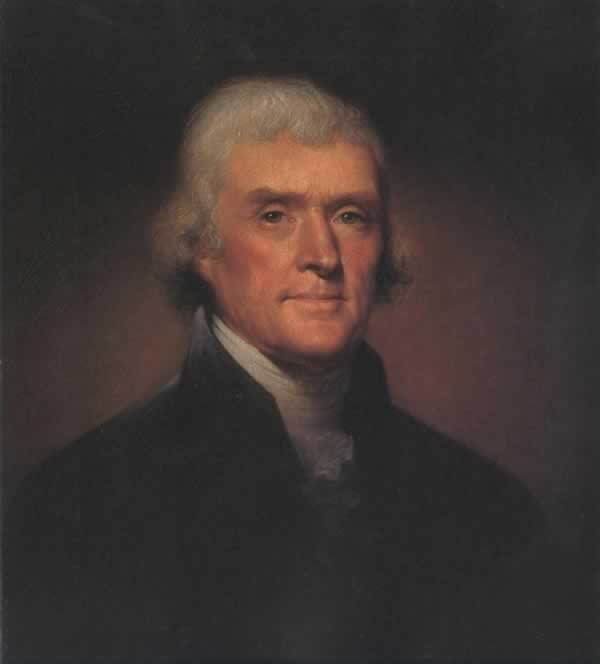
Jefferson's dedication to "consent of the governed" was so thorough that he believed that individuals could not be morally bound by the actions of preceding generations. This included debts as well as law. He said that "no society can make a perpetual constitution or even a perpetual law. The earth belongs always to the living generation." He even calculated what he believed to be the proper cycle of legal revolution: "Every constitution then, and every law, naturally expires at the end of nineteen years. If it is to be enforced longer, it is an act of force, and not of right." He arrived at nineteen years through calculations with expectancy of life tables, taking into account what he believed to be the age of "maturity" - when an individual is able to reason for himself. He also advocated that the national debt should be eliminated. He did not believe that living individuals had a moral obligation to repay the debts of previous generations. He said that repaying such debts was "a question of generosity and not of right."
Jefferson's very strong defense of States' rights, especially in the Kentucky and Virginia Resolutions of 1798, set the tone for hostility to expansion of federal powers. However, some of his foreign policies did in fact strengthen the government. Most important was the Louisiana Purchase in 1803, when he used the implied powers to annex a huge foreign territory and all its French and Indian inhabitants. His enforcement of the Embargo Act of 1807, while it failed in terms of foreign policy, demonstrated that the federal government could intervene with great force at the local level in controlling trade that might lead to war.
Jefferson's commitment to liberty extended to many areas of individual freedom. In his "Commonplace Book," he copied a passage from Cesare, Marquis of Beccaria related to the issue of gun control. The quote reads, "Laws that forbid the carrying of arms ... disarm only those who are neither inclined nor determined to commit crimes ... Such laws make things worse for the assaulted and better for the assailants; they serve rather to encourage than to prevent homicides, for an unarmed man may be attacked with greater confidence than an armed man."
For Jefferson, separation of church and state was a necessary reform of the religious "tyranny" whereby a religion received state endorsement, and those not of that religion were denied rights, and even punished.
Jefferson owned many slaves over his lifetime. Some find it baffling that Thomas Jefferson owned slaves yet was outspoken in saying that slavery was immoral and it should be abolished. Biographers point out that Jefferson was deep in debt and had encumbered his slaves by notes and mortgages; he chose not to free them until he finally was debt-free, which he never was. Jefferson seems to have suffered pangs and trials of conscience as a result. He wrote about slavery, "We have the wolf by the ears; and we can neither hold him, nor safely let him go. Justice is in one scale, and self-preservation in the other."
During his long career in public office, Jefferson attempted numerous times to abolish or limit the advance of slavery. According to a biographer, Jefferson "believed that it was the responsibility of the state and society to free all slaves." In 1769, as a member of the House of Burgesses, Jefferson proposed for that body to emancipate slaves in Virginia, but he was unsuccessful. In his first draft of the Declaration of Independence, Jefferson condemned the British crown for sponsoring the importation of slavery to the colonies, charging that the crown "has waged cruel war against human nature itself, violating its most sacred rights of life and liberty in the persons of a distant people who never offended him, captivating & carrying them into slavery in another hemisphere." However, this language was dropped from the Declaration at the request of delegates from South Carolina and Georgia.
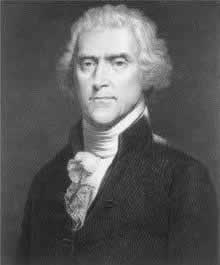
In 1778, the legislature passed a bill he proposed to ban further importation of slaves into Virginia; although this did not bring complete emancipation, in his words, it "stopped the increase of the evil by importation, leaving to future efforts its final eradication." In 1784, Jefferson's draft of what became the Northwest Ordinance stipulated that "there shall be neither slavery nor involuntary servitude" in any of the new states admitted to the Union from the Northwest Territory.
The downturn in land prices after 1819 pushed Jefferson further into debt. Jefferson finally emancipated his five most trusted slaves; the others were sold after his death to pay his debts.
Whether Jefferson fathered children with Sally Hemings is the subject of considerable controversy. Regarding marriage between blacks and whites, Jefferson wrote that "[t]he amalgamation of whites with blacks produces a degradation to which no lover of his country, no lover of excellence in the human character, can innocently consent." In addition, Hemings was likely the half-sister of Jefferson's deceased wife Martha Wayles Skelton Jefferson. The allegation that Jefferson fathered children with Hemings first gained widespread public attention in 1802, when controversial journalist James T. Callender, wrote in a Richmond newspaper, "...[Jefferson] keeps and for many years has kept, as his concubine, one of his slaves. Her name is Sally." Jefferson never responded publicly about this issue but is said to have denied it in his private correspondence.
A 1998 DNA study concluded that there was a DNA link between some of Hemings descendants and the Jefferson family, but it did not conclusively prove that Jefferson himself was their ancestor. Three studies were released in the early 2000s, following the publication of the DNA evidence. In 2000, the Thomas Jefferson Foundation, which runs Monticello, appointed a multi-disciplinary, nine-member in-house research committee of Ph.D.s and an M.D. to study the matter of the paternity of Hemings's children. The committee concluded "it is very unlikely that any Jefferson other than Thomas Jefferson was the father of [Hemings's six] children."

In 2001, the Thomas Jefferson Heritage Society commissioned a study by an independent 13-member Scholars Commission. The commission concluded that the Jefferson paternity thesis was not persuasive. On April 12, 2001, they issued a report; at 565 pages, it was far longer than the Foundation report, though many of those pages were devoted to a review of the evidence that the Thomas Jefferson Foundation study examined. The conclusion of most of the Scholars Commission was that "the Jefferson-Hemings allegation is by no means proven"; those members' individual conclusions ranged from "serious skepticism about the charge" to "a conviction that it is almost certainly false." The majority suggested the most likely alternative is that Randolph Jefferson, Thomas's younger brother, was the father of Eston.
The National Genealogical Society Quarterly then published articles reviewing the evidence from a genealogical perspective and concluded that the link between Thomas Jefferson and Sally Hemings was valid.
There are many portraits of Thomas Jefferson today, as well as statues, sketches, etchings and other depictions of his likeness. As the president of the United States, he had a number of portraits commissioned for personal and public use. While a great majority of these are in public or government collections, the likelihood of other Jefferson portraits being in existence is great.
The Sally Hemings theory provides the most likely opportunity for Jefferson paintings to be owned in a private collection. As the mother of his children, it is not unthinkable that he would have given her a miniature portrait or some other representation of his likeness as a token of his affection. Likewise, his biological children may have also had access to images of their father. The possibilities are endless, but one this is for certain; any new portrait found of Thomas Jefferson would create instant media buzz and would be worth a fortune. Not only would they hold significant value, but they would have likely been painted by an artist of note, such as Rembrandt and Charles Wilson Peale, giving them even more value.
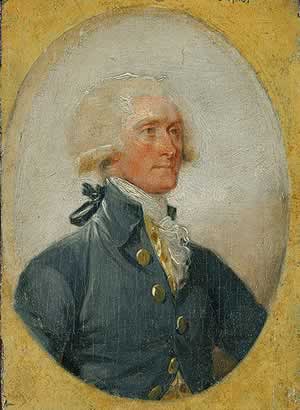
Still wondering about a painting in your family collection? Contact us...it could be a portrait of Thomas Jefferson.
